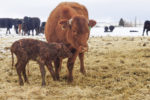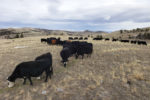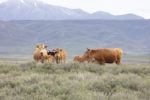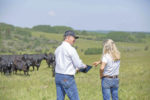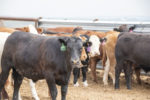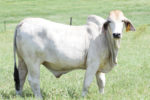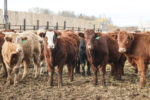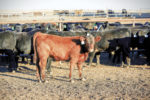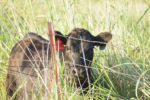Cattle Management
Colostrum is packed with antibodies and proteins and includes energy and vitamins necessary for the future health and productivity of the calf, but it must be ingested within 12 hours of birth to be effective.
Read More
Preparing for the upcoming calving season
Keeping a finger on the pulse of your cow herd’s needs in the weeks prior to calving will pay big dividends when calves start hitting the ground.
Read More
Are we getting enough from range calves?
Range-raised calves typically turn out lighter than their irrigated pasture-raised counterparts. Backgrounding and finishing practices are critical to catching them up carcass-wise.
Read More
Rely on your bovine veterinarian for improved herd outcomes
A good relationship with your veterinarian, when combined with modern chuteside data-collecting tools, can help your cattle achieve their full genetic potential.
Read More
Rotavirus in calves: What is causing the problem and how do we address it?
Rotavirus is a common enteric pathogen resulting in dangerous dehydration due to its effect on the intestinal lining. Treatment should focus on correcting the loss of fluids and electrolytes, while effective prevention measures include biosecurity and vaccination protocols.
Read More
Implanting before the feedyard and why it pays
Several misconceptions about the feedlot performance of implanted cattle exist. However, animals that have received growth implants prior to entering the feedlot consistently outperform those that haven’t.
Read More
Opportunities and obstacles for Brahman steers on pasture and in feedlot
Feedyards often shy away from taking on Brahman steers, but they can be a profitable option for feeders who do their due diligence to prepare for these unique cattle.
Read More
Feedlot efficiency and safety: Prioritizing cattle welfare and operational excellence
Cattle handlers should emphasize safety, efficiency and receiving protocols to ensure success in the feedlot.
Read More
Manage the whole system to stay ahead of BRD outbreaks
High calf prices may compel stockers and feedlots to buy riskier, BRD-prone cattle. Proper management and on-arrival practices reduce health risks and promote successful feeding programs.
Read More
Planning: The key to backgrounding on grass
When carefully considered, backgrounding calves to different weights can offer a path to more profitability for cow-calf producers as they market their calves at less conventional times.
Read More
